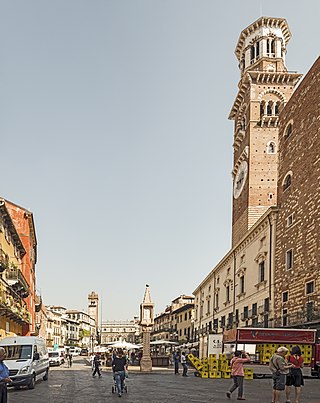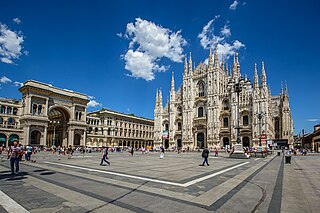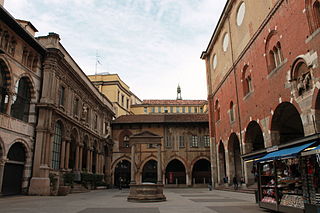
Piacenza is a city and comune (municipality) in the Emilia-Romagna region of Northern Italy, and the capital of the eponymous province. As of 2022, Piacenza is the ninth largest city in the region by population, with more than 102,000 inhabitants.

Piazza delle Erbe is a square in Verona, northern Italy. It was once the town's forum during the time of the Roman Empire.

Piazza del Duomo is the main piazza of Milan, Italy. It is named after, and dominated by, Milan Cathedral. The piazza marks the center of the city, both in a geographic sense and because of its importance from an artistic, cultural, and social point of view. Rectangular in shape, with an overall area of 17,000 m2, the piazza includes some of the most important buildings of Milan, as well some of the most prestigious commercial activities, and it is by far the foremost tourist attraction of the city.

Villas and palaces in Milan are used to indicate public and private buildings in Milan of particular artistic and architectural value. The lack of a royal court did not give Milan the prerequisites for a significant development of building construction; nevertheless it contains architectural works from different eras and different styles: from Romanesque to neo-Gothic, from Baroque to eclectic, from Italian twentieth century to rationalism.

Piazza Cordusio is a square in central Milan, Italy. The piazza takes its name from the Cors Ducis which was located on the square during Longobard times. It is well known for its several turn-of-the-19th-century Neoclassical, eclectic and Art Nouveau buildings, banks and post offices. Even though many of these have now relocated elsewhere, it is still an important commercial square in the city and hosts the Palazzo delle Assicurazioni Generali, the Palazzo del Credito Italiano and the Palazzo delle Poste, former Borsa di Milano. Piazzale Cordusio hosts the Cordusio metro station and is the starting point of the elegant pedestrian Via Dante which leads to the imposing medieval Castello Sforzesco, or Milan Castle. Opposite to Via Dante, Cordusio borders onto Piazza Mercanti, former city centre in the Middle Ages, which leads directly to Piazza del Duomo, today's city centre.

The Palazzo della Ragione is a historic building of Milan, Italy, located in Piazza Mercanti, facing the Loggia degli Osii. It was built in the 13th century and originally served as a broletto as well as a judicial seat. As it was the second broletto to be built in Milan, it is also known as the Broletto Nuovo.

Palazzo Marino is a 16th-century palace located in Piazza della Scala, in the centre of Milan, Italy. It has been Milan's city hall since 9 September 1861. It borders on Piazza San Fedele, Piazza della Scala, Via Case Rotte and Via Tommaso Marino.

Piazza Mercanti is a central city square of Milan, Italy. It is located between Piazza del Duomo, which marks the centre of the modern city of Milan, and Piazza Cordusio, and it used to be the heart of the city in the Middle Ages. At the time, the square was larger than it is now and known as "Piazza del Broletto", after the "Broletto Nuovo", the palace that occupied the centre of the square. In the 13th century, there were six entry points to the square, each associated to a specific trade, from sword blacksmiths to hat makers.

Casa Panigarola, also known as Palazzo dei Notai, is a historic building of Milan, Italy, located in Piazza Mercanti, former city centre in the Middle Ages. It is named after the House of Panigarola, a family of notaries from Gallarate, that owned the building until 1741. The building thus served as a notary seat, and the activities therein were strictly related to those that occurred in the adjacent Palazzo della Ragione, where trials were held.

The Giureconsulti Palace, also known as Palazzo Affari ai Giureconsulti or simply Palazzo Affari, is a 16th-century building of Milan, Italy. It is located in Piazza Mercanti, former city centre in the Middle Ages.

Palazzo dello Strozzino is a Renaissance palace in Florence, Italy. The stone Renaissance facade is located on Piazza degli Strozzi, diagonal to the Southeast corner of the imposing Palazzo Strozzi. The Northern façade on Via dei Anselmi houses the entrance to the Cinema Odeon.

The Gazzola Institute is a school of the arts and art museum, located on via Gazzola n°9 in the town of Piacenza, region of Emilia Romagna, Italy.

The Palazzo della Prefettura also called the Palazzo Scotti di Vigoleno is a Baroque architecture-style palace located on Via San Giovanni #17 in central Piacenza, region of Emilia-Romagna in Italy. The palace houses the offices of the provincial administration.

Palazzo Comunale is a Gothic style palace located facing Piazza del Cavalli in the historic center of Piacenza, northern Italy which now serves as the seat of municipal administration. The facade is flanked by two bronze equestrian statues sculpted by Francesco Mochi and depicting the Farnese Dukes of Parma: Ranuccio (1612–20) and his father, Alexander (1620-1629). Across the piazza is the late-Baroque or early neoclassic Palazzo del Governatore (1787) designed by Lotario Tomba. Recessed and to the right is the 17th-century Collegio dei Mercanti.

Palazzo del Governatore is a neoclassic-style palace located facing Piazza dei Cavalli in the historic center of Piacenza, northern Italy which now houses the town's chamber of commerce. The facade is flanked by two bronze equestrian statues sculpted by Francesco Mochi and depicting the Farnese Dukes of Parma: Ranuccio (1612–20) and his father, Alexander (1620-1629). Across the piazza is the Gothic-style Palazzo Comunale and the two equestrian statues of Farnese dukes, Alessandro and Ranuccio.

San Vincenzo is a Baroque style, Roman Catholic church, now deconsecrated, located at Via Scalabrini #6 in the South-East quadrant of Piacenza, Region of Emilia Romagna, Italy. The church was restored starting in 2009 for use as an auditorium and to host concerts.

Piazza dei Cavalli is one of the oldest and main public squares in the historic center of the city of Piacenza, Italy. Once called Piazza Grande, it competes with the Piazza del Duomo, located some 4 blocks southeast for prominence. This square, unlike the latter, is mainly ringed by secular buildings relating to the political and business community.

Palazzo Mandelli is a Baroque architecture-style palace located at the corner of Vie Bernardino Mandelli and San Marco in central Piacenza, region of Emilia-Romagna in Italy. The main portal rises in front of the church of San Dalmazio. The palace is presently home to the Banca d'Italia in Piacenza.

The Palazzo Landi is a Renaissance-style palace located on Via dei Consiglio #15 in the historic center of Piacenza, northern Italy.



















